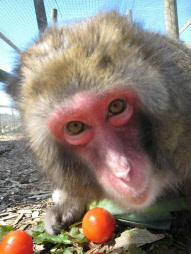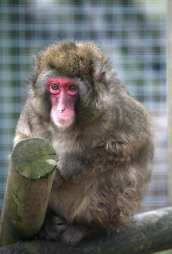

Macaques are old World monkeys and after man are the most widely distributed primate, ranging from Afghanistan to Japan. The famous Barbary Apes on the Rock of Gibralter are Macaques. These and some other Macaques have no tail and are erroneously referred to as apes, whereas all are true monkeys and are not closely related to true apes.
t
Lion-tailed Macaque, Macaca silenus
Southern Pig-tailed Macaque or Beruk, Macaca nemestrina
Northern Pig-tailed Macaque, Macaca leonina
Pagai Island Macaque, Macaca pagensis
Siberut Macaque, Macaca siberu
Moor Macaque, Macaca maura
Booted Macaque, Macaca ochreata
Tonkean Macaque, Macaca tonkeana
Heck's Macaque, Macaca hecki
Gorontalo Macaque, Macaca nigriscens
Celebes Crested Macaque, Macaca nigra
Crab-eating Macaque, Macaca fascicularis (Picture top left)
Stump-tailed Macaque, Macaca arctoides
Rhesus Macaque, Macaca mulatta
Formosan Rock Macaque, Macaca cyclopis
Japanese Macaque, Macaca fuscata (Picture bottom left)
Toque Macaque, Macaca sinica
Bonnet Macaque, Macaca radiata
Assam Macaque, Macaca assamensis
Tibetan Macaque, Macaca thibetana
Arunachal Macaque, Macaca munzala
Barbary Macaque, Macaca sylvanus
Macaque Species List


Most Macaques are diurnal, sleeping by night and foraging by day. They are both arboreal and terrestrial, and mostly herbivorous, feeding on leaves, pine needles, roots, and the occasional insect or small animal. They have specialized pouch-like cheeks, allowing them to temporarily hoard their food.
Their main predators are birds of prey, dogs, weasels, leopards, tigers, sharks, crocodiles, and snakes.
Julie was found wandering in the streets of Antwerp. She is a Japanese Macaque and as you can see she has a striking red face and large brown eyes.
Macaques have an intricate social structure which recognises different levels of status.They submit to other Macaques of a higher social standing.
A higher ranking monkey is even allowed to remove food from the mouth of a lower ranking member of the troop without an argument ensuing.
They live in troops which may contain several hundred animals, although several dozen is more common. Troops are likely to consists of three or four females to every male. In this respect they are similar to Baboons, to whom they are closely related.
Rhesus macaques are noted for their tendency to move from rural to urban areas, coming to rely on handouts or refuse from humans. They have become a pest in some areas, particularly in India, and are often perceived as a possible risk to public health and safety. They are excellent swimmers and like to enter water.